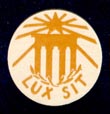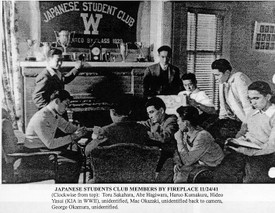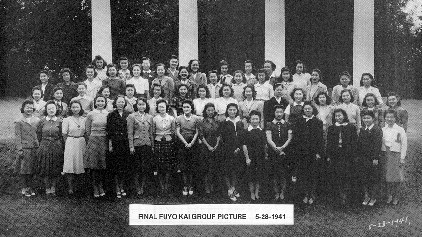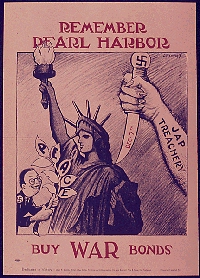Regular Joes & Betty Coeds — Japanese Students at the UW
In the fall of 1941, there were over 400 students of Japanese ancestry enrolled at the University of Washington; most were American citizens, or Nisei (second generation). 1 They were regular Joes and Betty coeds, indistinguishable from their classmates but for their features and names. They majored predominately in areas of science and business, professions that first-generation parents, the Issei, thought would result in more stable job prospects and economic security.2 However there were students with interests in more than twenty disciplines, ranging from advertising to nursing and from engineering to pharmacy.3 As a group, their academic performance was a bit better than the average UW student; many would receive honors in absentia in June of 1942.4
College fraternities prior to the 1950s restricted membership either overtly or covertly to Whites with Protestant affiliation. Jews and people of color were not allowed to join. In response Jews, African Americans and Asian Americans formed their own fraternities. On the University of Washington campus, Japanese Americans, excluded from traditional fraternities and sororities, founded their own clubs: the Japanese Student Club (JSC) for men and the Fuyo Kai (Hibiscus Club) for women.
The Japanese Student Club was founded in 1922 under the name University Students' Club. Membership was not restricted by race, nationality or creed. A clubhouse, funded by donations from Japanese Americans, was purchased across the street from campus. The clubhouse provided a lounge as well as a dormitory for out-of-town students.5 The JSC was for all intents and purposes a social fraternity. The 1926 Quarterly, a club publication, stated that "The Japanese Students' Club has come to mean the center of Japanese student life, as Eagleson Hall, the International House, Tillicums, the fraternities and the sororities are the center of the student life of the varigated groups on the campus."6
Fuyo Kai was established in 1925, succeeding an earlier group, the Japanese Progressive Women's club (1921 – 1925). The Constitution of Fuyo Kai stated three goals: 1) "to bring together the Japanese Women students into closer relationship," 2) "to attain a better understanding of the highest ideals of Japan and America and 3) "to be an instrument of service to our Alma Mater."7
The usual activities were held: monthly meetings, dances with the JSC, panhellenic dinners, quarterly pledge initiations, and spring teas. The sole surviving copy of the club newsletter, Fuyo-Kai Fulcrum, at the University of Washington archives, resonates with quintessential themes of coed life of the early 1940s such as music (White Cliffs of Dover is the favorite), fashion ("When betty co-ed wants to turn all her glamour on her boyfriend she can wear a black velveteen date frock...") and romance ("the boys we'd like to kiss goodbye").8 In this issue, initiation antics are featured in full, light-hearted detail:
BRIEFS FROM THE JSC INITIATION: BEEFO AMABE crawling on his stomach on a "corn flaked" floor. SHO NOJIMA passing out from the limburger and marshmallow combination. Bashful fellows like RICHARD IMAI having to get thirty Fuyo-Kai gal's signatures. YOSH HONKAWA'S looking like Dagwood Bumstead in his bow tie. AL OUCHI reading poetry to a certain miss....under the watchful eyes of ABE HAGIWARA and GEORGE KOSAKA. SAM SAKAI having to don a red bow tie.9
On December 5, 1941, two days before Pearl Harbor, the Fuyo Kai sponsored a "Draftee Party" for Japanese American soldiers from Fort Lawton and Fort Lewis. The minutes from December 5th note that "60 army men were present."10
In addition to membership in the JSC and Fuyo Kai, Nisei students also participated in scholastic societies and clubs such as Phi Beta Kappa, Pi Mu Chi, the Home Economics Club, and the YMCA and YWCA.11 Some were lettermen — Joe Kesamura in baseball, Tad Fujioka in swimming, and Frank Watanabe in tennis.
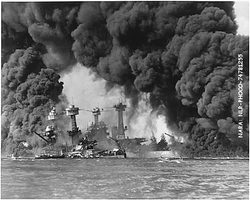 All this changed with the attack on Pearl Harbor. On the evening of December 7 the FBI began to round up community leaders and police departments raided homes for contraband such as shortwave radios, hunting rifles and samurai swords. By December 9 more than 1,200 people of Japanese descent were in custody nationwide.12 The arrests caused panic amongst the Japanese American community. According to Reverend Daisuke Kitagawa of St. Paul's Church outside Seattle, "every male lived in anticipation of arrest by the FBI, and every household endured each day in fear and trembling."13
All this changed with the attack on Pearl Harbor. On the evening of December 7 the FBI began to round up community leaders and police departments raided homes for contraband such as shortwave radios, hunting rifles and samurai swords. By December 9 more than 1,200 people of Japanese descent were in custody nationwide.12 The arrests caused panic amongst the Japanese American community. According to Reverend Daisuke Kitagawa of St. Paul's Church outside Seattle, "every male lived in anticipation of arrest by the FBI, and every household endured each day in fear and trembling."13
UW student Dick Takeuchi was sent out to report the reactions of fellow Japanese American students to the bombing of Pearl Harbor. His article in the special war edition of the Daily is filled with exclamations of shock and disbelief. Students were also keenly aware of the possible ramifications of war between the United States and Japan. In a prescient moment the term "concentration camp" appeared in print:
As war, or undeclared war became a reality, the shock to these students was reflected and magnified in their parents, most of whom are Japanese citizens. That their parents may be confined in a concentration camp while they faced discrimination and suspicion was held not impossible by many of the students.
"We hoped at first that it was German raiders. It's still unbelievable."
Such was the first reaction of American-born Japanese University students who sat huddled around the radio in their clubhouse last night, and utterly bewildered, tried to imagine that the country of their ancestors had actually attacked the United States.
—University of Washington Daily, Dec. 8, 194114
In the early days after Pearl Harbor, many church groups and universities united behind their Japanese American students. University of Washington President Lee Paul Sieg stated in the Japanese American Courier, "I am confident that the great majority of [Japanese Americans] will join with all Americans, regardless of ancestry, origin, creed or color, to bring this conflict to a successful conclusion."15
Despite the calls for tolerance and support for the Nisei, Mike Masaoka, national secretary of the Japanese American Citizen's League (JACL) warned:
Just because many of the restrictions are being relaxed, we must not dismiss the troubles of the past month as horrible nightmares and confidently await a return to our former status. The longer the war drags on — as casualty lists are published, West Coast cities are shelled or bombed, atrocities committed — the tougher our situation will become. Public sympathy may wear away, perhaps hate and prejudice will replace the present tolerance and forbearance.
We must gird our loins, tighten our belts and prepare for the hardest fight in our generation, a fight to maintain our status as exemplary Americans, who, realizing that modern war demands great sacrifices, will not become bitter or lose faith in the heritage which is ours as Americans, in spite of what may come; a fight that will not be won in a week, or months, or even years; a fight which will test our mettle and our courage; a fight in which we must make heroic sacrifices equal to those made on the battlefield, but also a fight in which we will be subjected to suspicions, persecutions, and possibly downright injustices.16
For Japanese Americans, Pearl Harbor and World War II were watershed events, affecting issues of identity, culture and generational change. Ties that the Issei (the first generation of immigrants) maintained with their ancestral home through business and cultural associations, familial interactions, and the use of the Japanese language, now became suspect. The Nisei, their children, by virtue of their American citizenship became almost overnight the leaders within the Japanese American community while the Issei were relegated to the sidelines (if not already detained by the police and FBI). Frank Miyamoto, an associate in the Department of Sociology, acknowledged this transferral of power in an article entitled "War Places Second Generation in Lead Once Taken by Elders," published in the Japanese American Courier: "Well, here it is at last. But where do we go from here, in particular, where do we Nisei go from here?"17
All segments of "Interrupted Lives: Japanese American Students at the University of Washington" are copyrighted by the University of Washington Libraries. "Interrupted Lives" may be used online. Segments of "Interrupted Lives" may be downloaded for personal use. The URL may be included in another electronic document.
